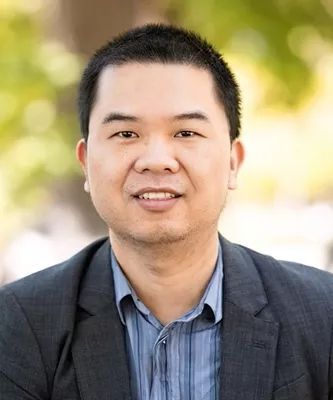杨永超
副教授
国家级人才
ycyang@eitech.edu.cn

背景介绍
杨永超分别于哈尔滨工业大学和美国莱斯大学获学士(2010)和博士(2014,导师:Satish Nagarajaiah)学位,在美国国家实验室任主任博士后(2015-2017,导师:Charles R. Farrar、David Mascarenas)、美国国家实验室研究员(2018-2019)、2019年起任美国密歇根理工大学机械工程-工程力学系助理教授。研究领域为结构动力学、结构感知与健康监测、智能系统、先进制造与机器人。在国际期刊上发表论文60多篇、参编3本专著、持美国专利2项(第一发明人),H-index 26,引用2700余次。2018年至今担任Structural Control and Health Monitoring (IF 6.0) 期刊编委,美国土木工程师学会(ASCE)结构控制与监测委员会成员及美国机械工程师学会(ASME)声学委员会成员。主要奖项为联合国纽约可持续发展会议最佳论文奖(2015)、美国土木工程师学会(ASCE)Raymond C. Reese研究奖(2017)、R&D 100奖(2018)、实验力学学会(Society for Experimental Mechanics, SEM)最佳论文奖(2021)及Young Investigator Lecture Award(2022 Plenary Lecture in 41st IMAC)、及国际结构健康监测Achenbach Medal(2022)。2019年以来每年均入选美国斯坦福大学全球前2%顶尖科学家。
详见主页:http://yongchao-yang.github.io
研究领域
结构动力学、结构感知与健康监测、桥梁工程、智能系统
教育背景
2010-2014:博士,美国莱斯大学土木工程系
2006-2010:学士,哈尔滨工业大学土木工程系
工作经历
2022-至今:宁波东方理工大学(暂名) 工学部长聘副教授
2019-2022:美国密歇根理工大学 机械工程与工程力学系助理教授(Tenure-track Assistant Professor)
2018-2019:美国国家实验室 研究员(Staff Scientist)
2015-2017:美国国家实验室 主任博士后(Director's Postdoctoral Fellow)
学术兼职(部分)
2018-至今:国际学术期刊《Structural Control and Health Monitoring》(影响因子6.0)副主编
2021-至今:美国土木工程师学会(ASCE)结构控制与监测委员会成员、美国机械工程师学会(ASME)声学委员会成员
加拿大、美国国家自然科学基金、能源部工程学科基金评审人 10多个国际会议共同组织者和分会场主席
20多个国际学术期刊审稿人
获奖情况及荣誉
2022:Young Investigator Lecture Award,美国实验力学学会(Society for Experimental Mechanics, SEM),Plenary Lecture(大会报告)41届国际模态分析大会(IMAC-XLI), Austin, TX, USA
2022:Achenbach Medal,国际结构健康监测委员会
2021:最佳论文奖Best Paper Award,美国实验力学学会(Society for Experimental Mechanics, SEM)
2018:R&D 100 Award
2017:Raymond C. Reese Research Prize,美国土木工程师学会(American Society of Civil Engineers, ASCE)
2015:最佳论文奖Best Paper Award,联合国纽约可持续发展大会
代表性论著
总体情况
60余篇SCI论文;参编3本专著章节 H-index 26, 引用总数超过2700
Google Scholar:https://scholar.google.com/citations?user=gVH1w4kAAAAJ&hl=en
Web of Knowledge:https://www.webofscience.com/wos/author/record/J-8640-2014
10篇代表作
S. Li; F. A. Azad; Y. Yang* (2023). Super-sensitivity full-field measurement of structural vibration with an adaptive incoherent optical method. Mechanical Systems and Signal Processing, 202, 110666.
A. Rostamijavanani; S. Li; Y. Yang* (2023). Data-Driven Modeling of Parameterized Nonlinear Dynamical Systems with a Dynamics-Embedded Conditional Generative Adversarial Network. ASCE Journal of Engineering Mechanics, 149(11), 04023094.
S. Li; F. A. Azad; Y. Yang* (2023). On the fundamental sensitivity limit of incoherent optical methods for full-field displacement measurements. IEEE Transactions on Instrumentation and Measurement, 72, 1009004.
S. Li; C. Farrar; Y. Yang* (2023). Efficient regional seismic risk assessment via deep generative learning of surrogate models. Earthquake Engineering & Structural Dynamics, 52(11), 3435-3454.
S. Li; Y. Yang* (2023). Efficient Data-Driven Modeling of Nonlinear Dynamical Systems via Metalearning. ASCE Journal of Engineering Mechanics, 149(3), 04023008.
S. Li; Y. Yang* (2022). Super-sensitivity incoherent optical methods for full-field displacement measurements. Optics Letters, 47(21), 5453-5456.
C. Dorn; S. Dasari; Y. Yang*; C. Farrar; G. Kenyon; P. Welch; D. Mascareñas (2018); Efficient full-field vibration measurements and operational modal analysis using neuromorphic event-based imaging, ASCE Journal of Engineering Mechanics, 144(7): 04018054
Y. Yang*; C. Dorn; T. Mancini; Z. Talken; C. Farrar; D. Mascareñas (2017); Blind identification of full-field vibration modes from video measurements with phase-based video motion magnification, Mechanical Systems and Signal Processing, 85: 567-590
Y. Yang; S. Li; S. Nagarajaiah; H. Li; P. Zhou (2016); Real-time output-only identification of time-varying cable tension from accelerations via complexity pursuit, ASCE Journal of Structural Engineering, 142(1): 04015083
Y. Yang; S. Nagarajaiah (2013); Time-frequency blind source separation using independent component analysis for output-only modal identification of highly damped structures, ASCE Journal of Structural Engineering, 139(10): 1780-1793





